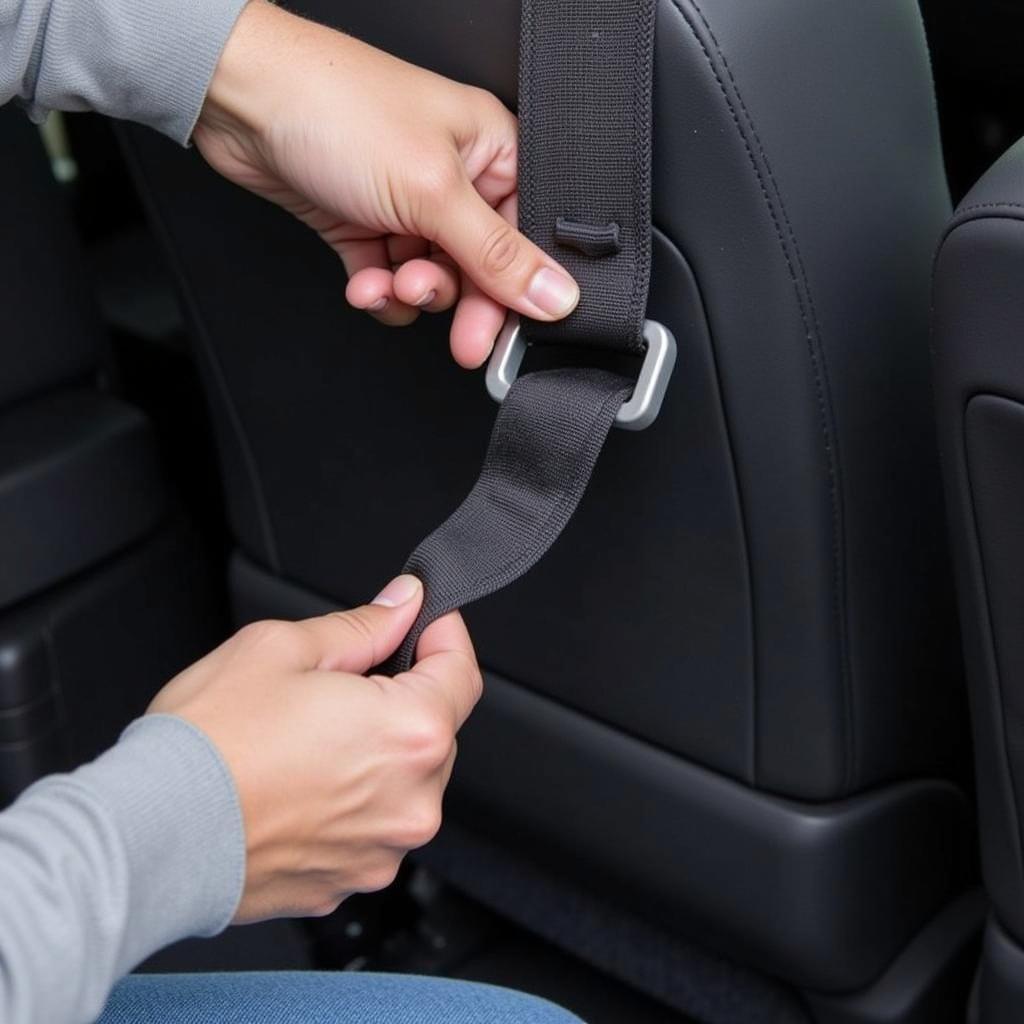The seat warning light on your dashboard can be a cause for concern, especially if you’re not sure what it means. This light, often appearing as a seated figure with a red or amber airbag icon, typically signals an issue with your vehicle’s occupant restraint system. This system, crucial for your safety in case of an accident, encompasses components like airbags, seat belts, and sensors. This article aims to demystify the seat warning light, guiding you through its various meanings, common causes, and potential solutions.
What Triggers the Seat Warning Light?
While the seat warning light primarily indicates a problem with the occupant restraint system, several specific issues can trigger its illumination:
- Faulty Seat Belt Buckle/Sensor: A malfunctioning seat belt buckle or its sensor can be a common culprit. This sensor detects if the seat belt is fastened, and a fault can lead to a false warning light even when buckled.
- Occupant Detection System Malfunction: Modern vehicles often incorporate weight sensors in the passenger seat to determine if an adult or child is present, adjusting airbag deployment accordingly. A fault in this system can trigger the warning light.
- Airbag System Issues: While a separate airbag warning light usually exists, problems within the airbag system, such as a faulty airbag control module or wiring harness issues, can also illuminate the seat warning light.
- Seat Position Sensor Problems: Some vehicles use sensors to monitor seat positioning for memory functions or advanced safety features. If these sensors malfunction, they can trigger the seat warning light.
Diagnosing the Seat Warning Light
Determining the exact cause of the seat warning light often requires specialized diagnostic equipment. While visually inspecting seat belts and connections for visible damage is a good starting point, a deeper dive usually involves:
- Scanning for Trouble Codes: Using an OBD-II scanner, a mechanic can read diagnostic trouble codes stored in your vehicle’s computer. These codes provide specific information about the area of the restraint system experiencing issues.
- Testing Individual Components: Based on the trouble codes, a mechanic can then test individual components like seat belt sensors, occupancy sensors, and wiring harnesses to pinpoint the faulty part.
 Mechanic Diagnosing Seat Warning Light
Mechanic Diagnosing Seat Warning Light
Common Seat Warning Light Scenarios and Solutions
Let’s delve into some specific scenarios involving the seat warning light and explore potential solutions:
1. Seat Warning Light Stays On Even With the Seat Belt Fastened
This is a common issue often stemming from a faulty seat belt buckle or sensor. Here are some troubleshooting steps:
- Check for Proper Connection: Ensure the seat belt is fully clicked into the buckle.
- Inspect the Buckle and Wiring: Visually examine the buckle and its wiring for any visible damage, such as bent pins, loose connections, or frayed wires.
- Clean the Buckle: Dust or debris inside the buckle can affect the sensor. Try cleaning it with compressed air.
 Inspecting Car Seat Belt Buckle
Inspecting Car Seat Belt Buckle
If these steps don’t resolve the issue, it’s likely the buckle or sensor needs replacement.
2. Seat Warning Light Flashes Intermittently
A flashing seat warning light can indicate a loose connection or a failing sensor. In addition to the steps mentioned above, consider:
- Checking Wiring Connections: Inspect the wiring harnesses under the seat for any loose connections, corrosion, or damage.
- Inspecting the Seat Occupancy Sensor: If your vehicle has one, check the occupancy sensor for any visible damage or debris.
“Intermittent issues can be tricky,” says automotive electrician Sarah Jones. “Sometimes a simple wiggle of the wiring harness can temporarily restore the connection, helping pinpoint the problem area.”
3. Seat Warning Light Comes On With Nothing on the Passenger Seat
This scenario often points towards a malfunctioning occupancy sensor. Potential solutions include:
- Recalibrating the Sensor: Some occupancy sensors can be recalibrated, which might involve specific procedures outlined in your vehicle’s owner’s manual.
- Replacing the Sensor: If recalibration doesn’t work, the sensor might need replacement.
It’s crucial to address any seat warning light issues promptly, as they directly impact the safety of you and your passengers. While some simple troubleshooting steps can be taken at home, consulting a qualified mechanic with experience in automotive electrical systems is recommended for diagnosis and repair, especially when dealing with complex components like airbags and restraint systems.
Frequently Asked Questions about Seat Warning Lights
Q: Can I drive with the seat warning light on?
A: While driving short distances with the seat warning light on might seem harmless, it’s strongly advised against. A malfunctioning occupant restraint system compromises safety, potentially leading to airbags not deploying correctly in an accident.
Q: How much does it cost to fix a seat warning light issue?
A: The cost can vary significantly depending on the root cause and your vehicle model. A simple sensor replacement might cost between $100 to $300, while more complex airbag system repairs could range from $500 to over $1000.
Q: Can I reset the seat warning light myself?
A: While some minor issues might resolve with a battery reset, attempting to reset the light without addressing the underlying problem is strongly discouraged.
Q: Does the seat warning light affect other vehicle functions?
A: In most cases, the seat warning light itself doesn’t directly impact other functions. However, the underlying issue, especially if related to the airbag system, can sometimes affect other safety features.
By understanding the seat warning light’s meaning, you can take the appropriate steps to ensure the safety and functionality of your vehicle’s crucial restraint system. Remember, when in doubt, consult a qualified professional for accurate diagnosis and repair.
